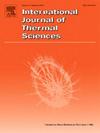液体射流冲击冷却的机器学习回归建模:基于计算流体力学(CFD)
IF 5
2区 工程技术
Q1 ENGINEERING, MECHANICAL
International Journal of Thermal Sciences
Pub Date : 2025-06-24
DOI:10.1016/j.ijthermalsci.2025.110086
引用次数: 0
摘要
综合CFD和机器学习回归模型(MLRM)研究优化了圆形射流撞击冷却。射流冲击受到多种参数的影响,在工业上得到了广泛的研究。本研究采用基于田口法(Taguchi Method, TM)的实验设计来确定CFD模拟的有效次数。数值模拟生成了一个数据集,用于分析喷嘴直径、喷嘴高度、流量和不同流体(水、纳米流体和微封装PCM),并通过实验数据进行验证。数据被清理并分成训练集、验证集和测试集。增强了验证和训练数据,而测试数据保持不变。在特征选择之后,分别训练6个奇异和6个集成rm来识别最佳模型,然后开发一个新的混合模型。混合模型的总R2 = 0.90,检验R2 = 0.84。适用性和敏感性分析验证了混合模型,然后进行了基于tm的方差分析。结果表明,流量是最重要的影响因素(51.5%),其次是流体类型(45.8%)。最后,应用了几种优化方法,其中Nelder-Mead方法预测了最佳情况(总误差为10%):在热流密度为64 W/cm2的情况下,Re = 5961.6导致平均= 4.6 (W/cm2°C)。本文章由计算机程序翻译,如有差异,请以英文原文为准。
Machine learning regression modeling of liquid jet impingement cooling: Based on computational fluid dynamics (CFD)
A comprehensive CFD and Machine Learning Regression Models (MLRM) investigation optimized circular Jet Impingement cooling. Jet impingement, influenced by several parameters, is widely studied in industry. This study used a design of experiments based on the Taguchi Method (TM) to determine the efficient number of CFD simulations. Numerical simulations generated a dataset to analyze nozzle diameter, nozzle height, flow rate, and different fluids (water, nanofluids, and Microencapsulated PCM), validated with experimental data. Data is cleaned and split into training, validation, and test sets. Validation and training data are augmented, while test data remained unchanged. After feature selection, 6 singular and 6 ensemble RMs are trained to identify the best models, followed by developing a novel hybrid model. The hybrid model achieved a total R2 = 0.90 and test R2 = 0.84. Applicability and sensitivity analysis validated the hybrid model, followed by a TM-based analysis of variance. Results revealed that flow rate is the most crucial factor (51.5%) followed by the fluid type (45.8%). Finally, several optimization methods are applied, with the Nelder-Mead method predicting the optimum case (with total error = 10%): Re = 5961.6 to result in an haverage = 4.6 (W/cm2 °C) given a heat flux of 64 W/cm2.
求助全文
通过发布文献求助,成功后即可免费获取论文全文。
去求助
来源期刊

International Journal of Thermal Sciences
工程技术-工程:机械
CiteScore
8.10
自引率
11.10%
发文量
531
审稿时长
55 days
期刊介绍:
The International Journal of Thermal Sciences is a journal devoted to the publication of fundamental studies on the physics of transfer processes in general, with an emphasis on thermal aspects and also applied research on various processes, energy systems and the environment. Articles are published in English and French, and are subject to peer review.
The fundamental subjects considered within the scope of the journal are:
* Heat and relevant mass transfer at all scales (nano, micro and macro) and in all types of material (heterogeneous, composites, biological,...) and fluid flow
* Forced, natural or mixed convection in reactive or non-reactive media
* Single or multi–phase fluid flow with or without phase change
* Near–and far–field radiative heat transfer
* Combined modes of heat transfer in complex systems (for example, plasmas, biological, geological,...)
* Multiscale modelling
The applied research topics include:
* Heat exchangers, heat pipes, cooling processes
* Transport phenomena taking place in industrial processes (chemical, food and agricultural, metallurgical, space and aeronautical, automobile industries)
* Nano–and micro–technology for energy, space, biosystems and devices
* Heat transport analysis in advanced systems
* Impact of energy–related processes on environment, and emerging energy systems
The study of thermophysical properties of materials and fluids, thermal measurement techniques, inverse methods, and the developments of experimental methods are within the scope of the International Journal of Thermal Sciences which also covers the modelling, and numerical methods applied to thermal transfer.
 求助内容:
求助内容: 应助结果提醒方式:
应助结果提醒方式:


